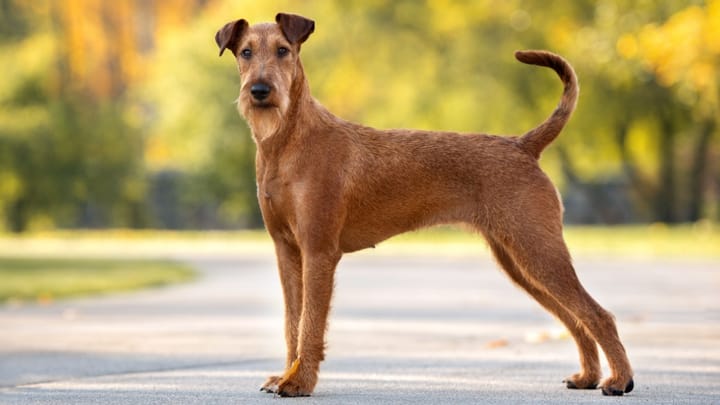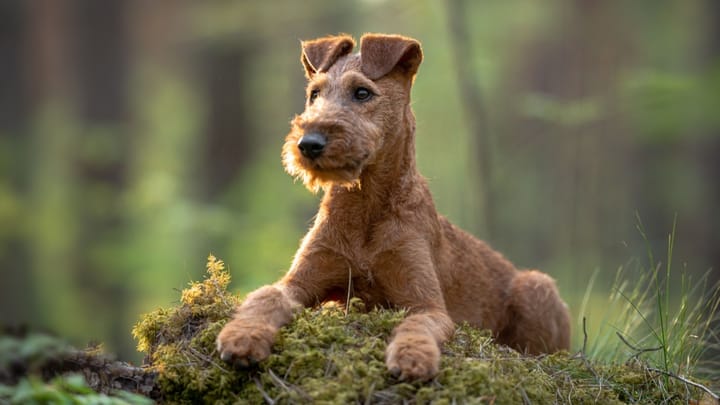Irish Terrier
Other name: Irish Red Terrier


The Irish terrier is an active, compact working dog that has become a popular choice as a household pet. Like most working dogs, the Irish Terrier is a lively, high-energy breed. They’re also very healthy and robust and are resistant to many diseases and other health complications. The Irish Terrier was bred as a pack animal, and so they're well known for their social dispositions and fondness for other dogs and small children.
|
Life expectancy |
The Irish Terrier has a life expectancy of between 13 and 15 years |
|
Temperament |
|
|
Size |
Medium
|
|
Adult size |
Female
Between 17 and 19 in
Male
Between 17 and 19 in
|
|
Adult weight |
Female
Between 24 and 29 lb
Male
Between 24 and 29 lb
|
|
Coat colour
An Irish Terrier’s coat will usually be light brown or tawny colour, although it can also be a reddish, rust type colour, or wheaten red. |
Red |
|
Type of coat
Irish Terriers have a short, straight and wiry topcoat with a soft and much thicker underlayer. Double layered with a thick undercoat. |
Long |
|
Eye colour
Dark brown. |
Brown
|
|
Purchase price |
The Irish Terrier costs between £570 and £1020 |
Irish Terriers are not a naturally obedient breed. Without the right training and socialisation, they will be very difficult to handle. An unsocialised terrier will be destructive, stubborn, and aggressive toward other dogs and family pets.
Terriers were bred to hunt foxes, badgers, and other den-dwelling animals, meaning they love to dig. If you don’t want them digging up your flowerbeds, you’ll need to create some space where your Terrier can satisfy this instinctual behaviour.
More details about the Irish Terrier
Irish Terrier: Origins and history
Experts believe that the Irish Terrier descended from the black and tan hunting breeds, and that it shares a common ancestry with the much larger Irish Wolfhound. The first breeding club was set up in Dublin in 1879. Shortly after, Irish Terriers were recognised as an official terrier breed by the English Kennel Club. They soon became a popular choice for farmers and hunters, gaining a reception for being excellent trackers and fearsome hunters halfway through the 20th century, Irish Terriers become a popular family pet, primarily for its fondness of young children.
Physical characteristics of the Irish Terrier
Irish Terriers have stocky frames with a deep chest. Their legs are much longer than most terriers, and they also have long necks and a high head carriage. This gives them a proud, elegant posture that is always ready for action. Irish Terriers have short, folded ears and longs muzzles covered with patches of long hair.
FCI classification of the Irish Terrier
-
Group 3 - Terriers
-
Section 1 : Large and medium sized Terriers
Irish Terrier: Characteristics
Irish Terrier: Behaviour
Training a Irish Terrier
Providing you understand the fundamental principles of positive training methods, the Irish Terrier is very easy to train. Without such techniques, the Irish Terriers independent streak can take over, and you'll have a very stubborn and disobedient dog on your hands. If you've never owned a dog before, then do plenty of research on reward-based training methods before adopting an Irish terrier. You may even want to invest in some professional help from a certified dog trainer.
Irish Terrier: Lifestyle
Breed compatibility Irish Terrier
Irish Terrier: Purchase price
The average cost of a purebred Irish Terrier puppy is somewhere between £570-£1020.
You'll also need to budget around £30-40 a month for feeding costs, and the average cost of a basic insurance policy is around £20,00 per month, although this varies from dog to dog. Yearly health checks, vaccinations, and other costs will add to an annual expense of around £900.
Irish Terrier: Shedding
Average
Irish Terriers are not prone to air loss, although they will shed quite heavily during warmer times of the year.
Irish Terrier: Grooming
A weekly brush will keep their coats clean and healthy. However, they will need a few trips to the dog groomer. Their thick undercoat must be hand-stripped by an expert and the hair between their paw pads will also need trimming. If left alone, this will soon become matted and dirty.
Irish Terrier: Health
The average lifespan for an Irish Terrier is between 13-15 years.
He is a very strong dog but can suffer from health problems despite his resistance and his courage.
Most terriers were bred in cold, harsh environments, hence their thick insulating undercoat. This will shed during summer and spring, although it's still good to give it an additional trim during hot periods of weather. This will reduce the risk of overheating.
Because of their double coat, Irish Terriers are highly resistant to cold weather. Their thick underlayer is extremely insulting, while the wiry topcoat protects them from rain and snow. Many Terriers were bred in the Scottish Highlands, so these dogs will have no problems surviving a standard British winter.
Like any dog, Irish Terriers will overeat if you let them. That being said, their naturally high energy levels and active nature means they’re unlikely to become obese. Still, it's important to feed them within the recommended guidelines.
- Cystinuria Sinuses
- Hyperkeratosis
- Hip Dysplasia
- Cataracts
- Hypothyroidism






